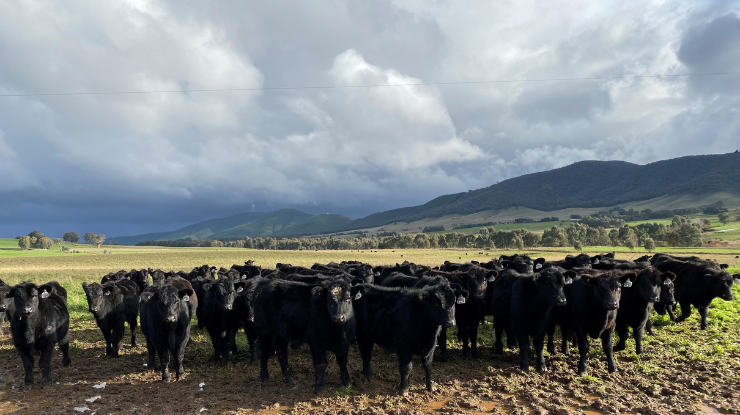 Cattle being monitored for liver fluke as part of the MLA Producer Demonstration Site. Image: Leah Tyrell
Cattle being monitored for liver fluke as part of the MLA Producer Demonstration Site. Image: Leah Tyrell
Flukicide timing tackles drench resistance
Liver fluke infection is prevalent in cattle and sheep across high rainfall areas (>600 mm) of south-east Australia, but producers have tools to target its complex lifecycle – delivering cost-savings and tackling drench resistance along the way.
A group of cattle producers in south-east NSW and north-east Victoria have been working together to optimise liver fluke management through an MLA-funded Producer Demonstration Site (PDS). The aim of the project was to improve understanding of the lifecycle and risk periods for liver fluke pick up and, by using drench more wisely, slow the development of drench resistance.
Here, PDS coordinator Leah Tyrell, from the University of Melbourne’s Mackinnon Project, shares insights from the project and how producers can lean on monitoring tools, grazing management and the strategic use of flukicide to control and prevent disease.
What is liver fluke?
Liver fluke (Fasciola hepatica) is a parasitic flatworm that affects livestock grazing in paddocks with slow moving water ways such as springs, seepages, creeks or irrigation channels.
Liver fluke larvae develop in a freshwater snail host found in these environments before passing from the snail and forming cysts that attach to pastures, which are then consumed by livestock.
Once ingested, the immature fluke migrates through body to the liver, then through the liver tissue before settling in the bile ducts where it then matures.
Signs to look out for
Symptoms in infected cattle can appear as:
- weight loss or reduced weight gain
- anaemia (pale gums and membranes around the eyes)
- jaundice
- bottle jaw (swelling below jaw).
“Liver fluke infection not only reduces productivity on-farm, it also reduces carcase value as damaged livers are condemned,” Leah said.
“Good on-farm control is not only critical for livestock health and productivity, but also to ensure the profitability of your business.”
Putting flukicide to the test
The project team conducted fluke egg counts (FECs) and drench efficacy tests on properties involved in the PDS, primarily targeting the most commonly used flukicide in the region: triclabendazole.
“The most striking finding was that every single property we tested showed some degree of resistance of triclabendazole,” Leah said.
“That was a huge wake-up call for many producers as they thought their drench was working just fine.
“For one participant, severe triclabendazole resistance meant they had to pull out of the trial within the first year due to risk of death on stock.
“However, if they didn’t get involved in the PDS in the first place, they may not have identified drench resistance as being the cause and may have had some significant hits to their herd and production as a result.”
Another participating producer had planned to move stock to another property on the day the project team told them they had drench resistance – preventing them from unknowingly transferring triclabendazole resistant liver fluke to that property.
However, another producer who consistently had very low FEC found the difference in performance between treated and untreated mobs was minimal. This suggested their cattle may not require annual treatment and monitoring for fluke infection at strategic times could potentially save the cost of a drench.
“This was where the importance of monitoring FEC came into play, not just in terms of controlling the disease, but also in terms of managing finances,” Leah said.
Timing the early winter strategic treatment was also crucial – weaners on one property which were treated late April were 13kg lighter than those treated in late May. This farm had high FEC, indicating the weaners continued to pick up liver fluke following the treatment in late April, whereas environmental conditions by late May meant liver fluke pick up was minimal.
Three steps to manage liver fluke
When it comes to ensuring strong control and management of liver fluke, there were three key takeaways from this PDS.
- Routine monitoring: conduct FEC before a planned early winter and early spring flukicide treatment to determine drench requirement.
- Check flukicide efficacy: consider a drench resistance trial on your property to understand the efficacy of flukicides.
- Incorporate liver fluke into grazing land management strategies: identify snail-prone paddocks and limit access for weaners and other vulnerable stock.
“Controlling liver fluke is not about throwing more chemical at the problem,” Leah said.
“It’s about being smarter with the tools we have.
“The success rate for producers who switched to a new flukicide during the project had significant success, and the ones who could see from FECs that they needn’t drench as often were able to save time and funds which could be better directed elsewhere.”



